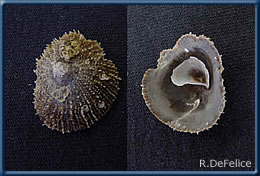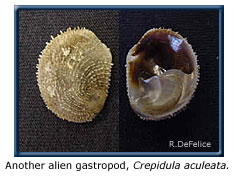

Anomia nobilis

Crassostrea virginica

Chama macerophylla

Crucibulum spinosum
Crucibulum spinosum
 Spiny
cup-and-saucer shell
Spiny
cup-and-saucer shell
Phylum Mollusca
Class Gastropoda
Subclass Prosobranchia
Order Neotaenioglossa
Family Calyptraeidae
Description
Low conical limpet-like shell with apex spirally coiled. Dorsal surface
of shell ray-white with spirally arranged spines or knobby projections.
Ventral surface of shell purple or black and smooth with a distinct cup-like
projection (from Kay 1979).
Another introduced intertidal gastropod, Crepidula
aculeata (Gmelin, 1791), is superficially similar to Crucibulum
when viewed dorsally. The ventral is smooth with similar coloration, but
with a shelf or deck, rather than than a cup.
 Habitat
Habitat
In harbors and embayments, on pier pilings, coral rubble and basalt rocks
from the intertidal to 8 m.
Distribution
Hawaiian Islands
Throughout the main islands
Native Range
Southern California to Chile
Present Distribution
World-wide in warm seas
Mechanism of Introduction
Unintentional, as fouling on ships' hulls
Impact
Fouling organism. Ecological impact unstudied, some competition for space
with native intertidal species likely.
Ecology
Feeding
Crucibulum spinosum is a ciliary feeder.
Reproduction
These gastropods are protandrous hermaphrodites, changing during the course
of their life from a small male into a full-grown female (Kay 1979). They
spawn throughout the year in Kaneohe Bay and can account for 90 percent
of the veliger component in the Bay in certain areas (Taylor 1975).
Remarks
Like many nonindigenous species, this small fouling gastropod species
appeared in the Hawaiian fauna soon after World War II. Keen (1971) noted
an Eastern Pacific distribution from California to the Gulf to Tomé,
Chile. Springsteen and Leobrera (1986) report it as introduced to the
Philippines. Given the volume of ship traffic between Pearl and Honolulu
Harbors and the Philippines, the appearance of C.
spinosum in other Pacific harbors is not a surprise. It is probably
now much more widespread, but goes unreported.
Edmondson (1946) appears to have been the first to remark on its presence
in Honolulu Harbor. By the late 1950s it was widespread around Oahu (Burgess
1959). Ulbrick (1969) reported that it occurred on pieces of dead coral
or basalt rocks dredged from sand and rock bottom at 5 to 8 meters in
Kaneohe Bay and that it was also found on seawalls and experimental trays
put out for oyster spat. It is now a common intertidal and shallow water
throughout the main islands, and continues to be reported in the literature.
References
Burgess, C.M. 1959. Where did this shell come from? Hawaiian Shell News.
7(8): 73.
Edmondson, C.H. 1946. Report of the Zoologist for 1946. B.P. Bishop Museum.
Kay, E.A. 1979. Hawaiian Marine Shells. Reef and Shore Fauna of Hawaii,
Section 4: Mollusca. B.P. Bishop Mus. Spec. Pub. 64(4), 653 pp.
Keen, A. 1971. Seashells of Tropical Western America. Stanford University
Press. 1064 pp.
Springsteen, F.J. and F.M. Leobrera. 1986. Shells of the Philippines.
Carfel Seashell Museum, Manila. 377 pp.
Ulbrick, M.L. 1969. Studies on Crucibulum spinosum
(Sowerby). Proc. Malacol. Soc. London 38: 431-438.
© 2002 Hawaii Biological Survey, Bishop Museum
contact